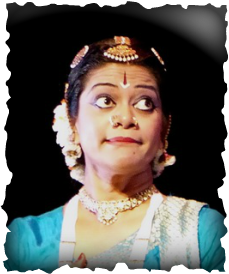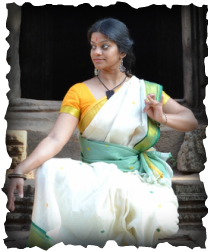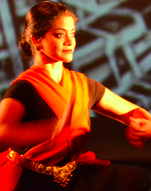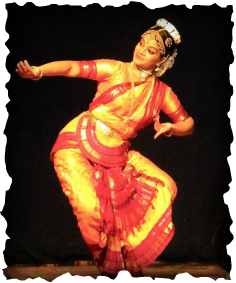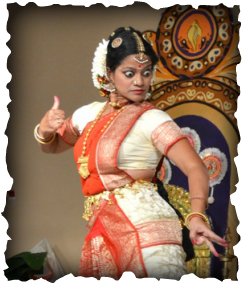Sumana Sen Mandala, MFA
Director
Sumana's initial training under Smt. Manjula Mudambi and then Kalashri Smt. Asha Gopal led to her arangetram (debut) in 1989 in Arizona, as a student of the Pandanallur school of Bharata-Natyam. Her experience during a summer intensive under Smt. Thankamani Kutty in Kolkata, India, encouraged her to refine her technique in abhinaya. While at the University of Virginia, Dr. Aruna Viswadoss guided her in more deeply examining Tamil language and literature for dance. Sumana spent 2 years in Sapporo, Japan, where she had the honor of studying and performing Kagura (Shinto ritual dance) with the Hokkaido Shrine Troupe and of being in conversation with buyō (舞踊) master and scholar Gunji-sensei (郡司正勝), exploring the practical and spiritual connections across cultures in dance. She also performed Bharata Natyam and conducted comparative dance workshops there.
Sumana sought guidance under Padma Bhushan Dr. Padma Subrahmanyam at Nrithyodaya, Chennai, India, in 1996 and spent 3 years immersed in a guru-shishya setting, working to master Bharata-Nrityam and the Natyashastra-based pedagogy of imparting Indian classical dance. As part of her training, she also learnt the Vazhuvoor style of Bharata-Natyam and served as research assistant to Dr. Padma and instructor for primary and intermediate classes at Nrithyodaya. She performed extensively in India with Dr. Padma's troupe, including the Chidambaram Natyanjali Festivals, Doordarshan, and a debut performance under Dr. Padma at Nungambakkam Cultural Academy (January 1999).
Sumana continues to perfect her art with practice, teaching, choreography, and further training and collaborations in dance arts, including earning a Master of Fine Arts (MFA) degree in Dance at Arizona State University (ASU) in 2020 and becoming an ASU Gammage Teaching Artist trained in the Kennedy Center Arts Integration method. She has published her work in peer reviewed journals and presented at various conferences in dance, education and equity. Sumana’s advocacy and facilitator training in Liz Lerman's Critical Response Process (CRP), the YWCA Minneapolis Racial Justice Circle Facilitation, and sexual and domestic violence prevention infuses her teaching and practice style to center collective knowledge, the value of every voice, and responsibility and response in any space she enters. Her current projects include preparing her students for their salangai puja, interdisciplinary collaboration called Prakriti, academic writing, teaching at ASU as an adjunct faculty, and taking her work LVHD to the next iteration.
Sumana sought guidance under Padma Bhushan Dr. Padma Subrahmanyam at Nrithyodaya, Chennai, India, in 1996 and spent 3 years immersed in a guru-shishya setting, working to master Bharata-Nrityam and the Natyashastra-based pedagogy of imparting Indian classical dance. As part of her training, she also learnt the Vazhuvoor style of Bharata-Natyam and served as research assistant to Dr. Padma and instructor for primary and intermediate classes at Nrithyodaya. She performed extensively in India with Dr. Padma's troupe, including the Chidambaram Natyanjali Festivals, Doordarshan, and a debut performance under Dr. Padma at Nungambakkam Cultural Academy (January 1999).
Sumana continues to perfect her art with practice, teaching, choreography, and further training and collaborations in dance arts, including earning a Master of Fine Arts (MFA) degree in Dance at Arizona State University (ASU) in 2020 and becoming an ASU Gammage Teaching Artist trained in the Kennedy Center Arts Integration method. She has published her work in peer reviewed journals and presented at various conferences in dance, education and equity. Sumana’s advocacy and facilitator training in Liz Lerman's Critical Response Process (CRP), the YWCA Minneapolis Racial Justice Circle Facilitation, and sexual and domestic violence prevention infuses her teaching and practice style to center collective knowledge, the value of every voice, and responsibility and response in any space she enters. Her current projects include preparing her students for their salangai puja, interdisciplinary collaboration called Prakriti, academic writing, teaching at ASU as an adjunct faculty, and taking her work LVHD to the next iteration.
|
|
|
|
Statement
I dance for beauty, power and community. Each stage of the process—body, mind, heart--builds up to squeeze out the juice from the stories i move. These stories grow from collaborations with my community partners. They grow when our histories and our present come together. We listen and witness. And we respond with dance, the sum of moving, thinking and feeling. When you join me, our dance will be the call to community—none out, all in.
I live in process where Bharata-Nrityam technique, collaboration and creative tools intersect.
I teach so my students can be close to Indian culture, but i also teach so they can more fully grow in their contemporary context. My work is my message to them and to all who engage: in “The Power of YOU,” that we are not alone and that we have choices; in “EMBRACE,” that observation and response are the foundation of meaningful change and that change is growth; in “Kriti,” that different perspectives help us move with greater meaning; and in “LVHD,” that each of us has the privilege of voice and the privilege to listen.

